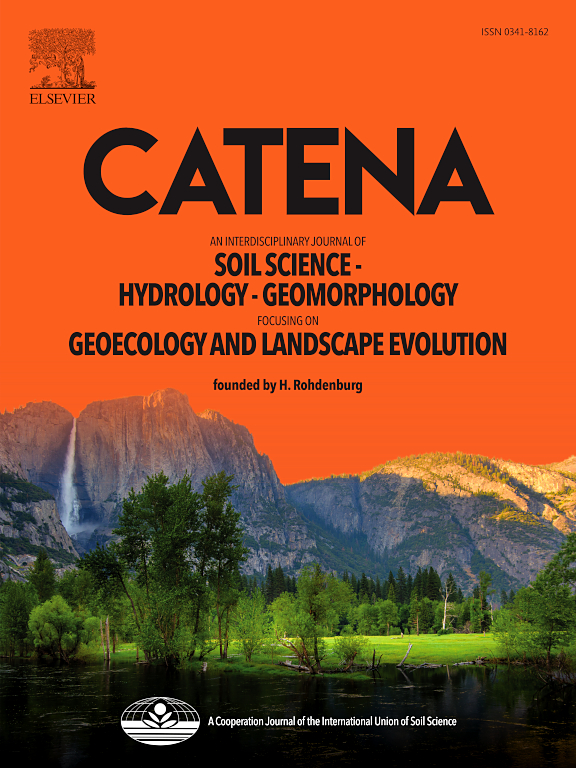ConToGCN: A landslide susceptibility assessment model considering contour topographic features in slope units using graph convolution network
IF 5.4
1区 农林科学
Q1 GEOSCIENCES, MULTIDISCIPLINARY
引用次数: 0
Abstract
Landslide susceptibility assessment (LSA) plays a critical role in disaster prevention and mitigation. While machine learning techniques have been widely applied to LSA with notable progress, they face limitations in LSA precision, and struggle to capture micro-topographic features with multi-points instead of single one in slope units. To address these limitations, this study proposes an LSA model based on contour topographic features and Graph Convolution Networks (ConToGCN). First, the graph structure for each slope unit is built by generating nodes and edges from contour lines. Next, 9 factors, including elevation, are extracted for graph nodes using feature engineering, and the steepness between nodes is calculated to identify critical features such as steep scarps and flow zones. The ConToGCN model is then developed to aggregate adjacent node features and generate landslide probability. Changxing County in Zhejiang, China, was selected as the study area. A dataset comprising 124 landslide and 124 non-landslide samples was collected, with 70% used for training and 30% for testing. A comparative performance evaluation was conducted against Graphormer, a GCN model based on slope unit centroids (CentGCN), Random Forest (RF), and Support Vector Machine (SVM). The results demonstrate ConToGCN model outperforms these other models, with an area under the ROC (AUROC) of 0.93 and an area under the PR curve (AUPR) of 0.94. This represents improvements of 14.81% and 14.63% over the SVM model, respectively. The ConToGCN model effectively captured the complex topographic structures and improved the LSA precision significantly. We believe the model provides a novel approach to landslide disaster prevention and mitigation.

基于图卷积网络的考虑坡单元等高线地形特征的滑坡易感性评价模型
滑坡易发性评估(LSA)在防灾减灾中发挥着至关重要的作用。虽然机器学习技术已被广泛应用于滑坡易损性评估,并取得了显著进展,但它们在滑坡易损性评估的精度方面存在局限性,难以捕捉多点而非单点的斜坡单元微地形特征。针对这些局限性,本研究提出了一种基于等高线地形特征和图卷积网络(ConToGCN)的 LSA 模型。首先,通过等高线生成节点和边,为每个斜坡单元建立图结构。然后,利用特征工程为图形节点提取包括海拔在内的 9 个因子,并计算节点之间的陡度,以识别陡峭疤痕和流动区等关键特征。然后开发 ConToGCN 模型,汇总相邻节点特征并生成滑坡概率。中国浙江省长兴县被选为研究区域。收集的数据集包括 124 个滑坡样本和 124 个非滑坡样本,其中 70% 用于训练,30% 用于测试。与 Graphormer、基于边坡单位中心点的 GCN 模型(CentGCN)、随机森林(RF)和支持向量机(SVM)进行了性能比较评估。结果表明,ConToGCN 模型优于其他模型,ROC 下面积 (AUROC) 为 0.93,PR 曲线下面积 (AUPR) 为 0.94。与 SVM 模型相比,分别提高了 14.81% 和 14.63%。ConToGCN 模型有效捕捉了复杂的地形结构,并显著提高了 LSA 精度。我们相信,该模型为滑坡灾害的预防和缓解提供了一种新方法。
本文章由计算机程序翻译,如有差异,请以英文原文为准。
求助全文
约1分钟内获得全文
求助全文
来源期刊

Catena
环境科学-地球科学综合
CiteScore
10.50
自引率
9.70%
发文量
816
审稿时长
54 days
期刊介绍:
Catena publishes papers describing original field and laboratory investigations and reviews on geoecology and landscape evolution with emphasis on interdisciplinary aspects of soil science, hydrology and geomorphology. It aims to disseminate new knowledge and foster better understanding of the physical environment, of evolutionary sequences that have resulted in past and current landscapes, and of the natural processes that are likely to determine the fate of our terrestrial environment.
Papers within any one of the above topics are welcome provided they are of sufficiently wide interest and relevance.
 求助内容:
求助内容: 应助结果提醒方式:
应助结果提醒方式:


